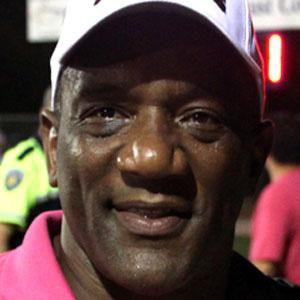Billy Sims
Billy Sims was born in St. Louis, Missouri, United States on September 18th, 1955 and is the Football Player. At the age of 69, Billy Sims biography, profession, age, height, weight, eye color, hair color, build, measurements, education, career, dating/affair, family, news updates, and networth are available.
At 69 years old, Billy Sims has this physical status:
Sims attended the University of Oklahoma, where he played for coach Barry Switzer's Oklahoma Sooners football team from 1975 to 1979. After playing only one game in his freshman year of 1975, injuries kept Sims out of the lineup for most of his sophomore season, which allowed him to red-shirt to gain an extra year of eligibility. Injuries continued to plague Sims for half of his (red-shirt) sophomore season in 1977 (he rushed for only 545 yards total in two seasons in 1975 and 1977, plus one game in 1976.) In 1978, Sims rushed for 1,762 yards on 231 carries as a red-shirt junior, averaging 7.6 yards per carry. Including the postseason, Sims had 1,896 yards. Both the before and after bowl game totals led the NCAA. He also set a total yardage school record that stood until 2004, when freshman Adrian Peterson ran for 1,925 yards. Subsequently, Sims was awarded the Heisman Trophy for the 1978 season, becoming only the sixth junior to do so. He was runner-up for the Heisman the following season in 1979, coming in second to Charles White of USC.
In 1979, against then-unbeaten Nebraska, who had the No. 1 rushing defense in the country at the time, Sims ran for 247 yards and helped the Sooners to a 17–14 win. Including the bowl game he had 248 attempts for 1,670 yards, averaging 6.7 yards per carry, and scored 23 touchdowns. He also became the first running back in Big 8 Conference (now merged to form the Big 12 Conference) history to rush for 200-yards in three consecutive games, and had four 200-yard games in a single season.
After losing to the Arkansas Razorbacks 31–6 in 1978, Sims led the Sooners to two consecutive Orange Bowl titles in three straight appearances. In the Orange Bowl following the 1978 season, he rushed for 134 yards and scored two touchdowns in a 31–24 win over the Nebraska Cornhuskers. In his final game, he ran for 164 yards as Oklahoma beat the previously-undefeated Florida State Seminoles by a score of 24–7. Sims ended his career at OU with 3,813 yards; most of those yards came in his final two seasons.
* Includes bowl games.
Professional career
As he expected, Sims was the first overall pick in the 1980 NFL Draft. He spent his career with the Detroit Lions, making the Pro Bowl in 1980, 1981, and 1982. Sims led Detroit to the playoffs in 1982 and 1983, but they lost in their first game in both appearances. In the 1983 NFC divisional playoff game at Candlestick Park against the San Francisco 49ers, Sims ran for 114 yards on 20 carries, but Joe Montana led the 49ers to a comeback victory, as Detroit kicker Eddie Murray missed a potential game-winning field goal in the waning moments.
In 1983, Sims' agent, Jerry Argovitz, took control of a USFL expansion franchise, the Houston Gamblers. On July 1, 1983, while seeking a new pact from the Lions, Sims secretly signed a five-year, $3.5 million contract with the Gamblers; in December, he also signed a new, five-year, $4.5 million contract extension with Detroit. The matter wound up in court, and on February 10, 1984, a federal judge voided the Houston pact, sending Sims back to Detroit.
Sims' career ultimately ended midway through the 1984 season when he suffered a catastrophic right knee injury in a game against the Minnesota Vikings on October 21; in that game, Sims set the all-time Lions rushing record (now held by Barry Sanders) with 5,106 yards on 1,131 carries, or 4.5 yards per carry. Sims also caught 186 passes for 2,072 yards (11.1 yards per catch). He spent two years attempting to rehabilitate his knee before finally retiring in 1986.
Sims remains a beloved sports figure in Detroit. His team uniform number 20 was worn five years after his retirement by Barry Sanders, and is currently retired as an unofficial "triumvirate" of the greatest Lions in the modern era to ever wear the number, which also includes Hall of Fame defensive back Lem Barney.
In 1988, four years after the knee injury that forced his retirement, Sims announced he was attempting a comeback with the Lions for the 1989 season. Speaking with Detroit Free Press columnist Mitch Albom, Sims claimed to be "as fit as he was in 1983." He offered to play the season with a blank check, allowing Lions management to assess his value and fill in the salary amount accordingly. Sims hoped to meet with then-General Manager Russ Thomas and owner William Clay Ford, Sr. to discuss a spot on the team's roster. Despite some interest from Lions head coach Wayne Fontes, Sims never returned to the NFL.
